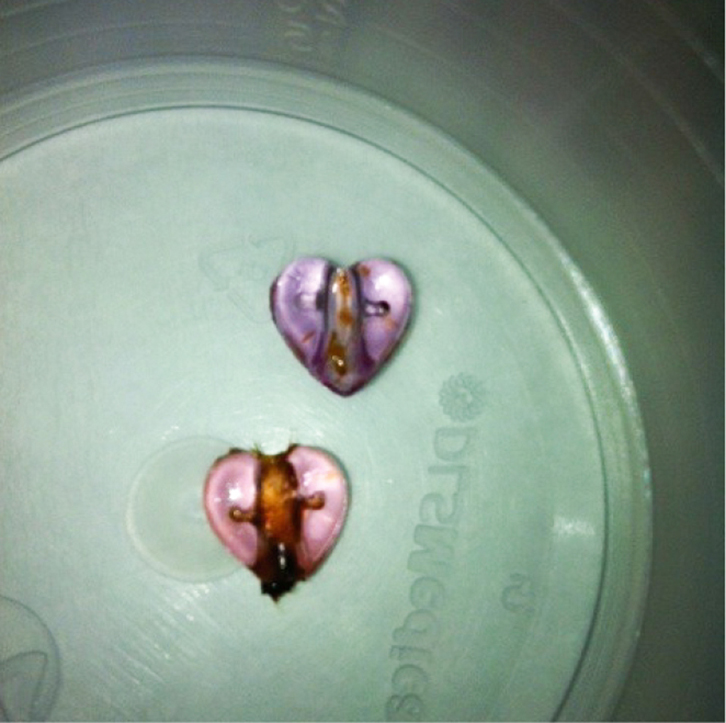Case study
 |
| Figure 1. Heart-shaped beads (aural foreign bodies), one removed from each of the external auditory canals of a girl, four years of age |
A girl, four years of age, presented with a one-week history of right-sided otalgia and otorrhoea. Otoscopy revealed impacted wax occluding the external auditory canal (EAC), partially obscuring an aural foreign body (AFB). Right-sided otitis externa secondary to AFB was diagnosed, and the patient was referred urgently to an ear, nose and throat (ENT) department.
The attending ENT consultant performed toileting of the cooperative child’s right ear. A pink, heart-shaped bead was removed, revealing an intact, erythematous tympanic membrane (TM). Examination of the contralateral left ear identified a further heart-shaped bead, which was also removed (Figure 1). Topical antibiotic drops were prescribed and the patient was discharged at follow-up.
Question 1
What are AFBs?
Question 2
Why do AFBs occur?
Question 3
How commonly do AFBs occur bilaterally?
Question 4
What are the sequelae of undiagnosed AFBs?
Question 5
How are AFBs diagnosed?
Question 6
How are AFBs managed?
Answer 1
AFBs are common in young children. Cotton, insects, beads, jewellery, paper and small toys are the most common types, accounting for up to 71% of cases.1 AFBs may be classified as organic (eg insects, peas) or inorganic (eg beads, earphone parts).
UK data revealed that between 2012 and 2013, 3142 cases of AFB required hospital admission.2 Research in Australia and North America has shown that 76–82% are referred from primary care,3,4 while peak incidence has been shown to be between 2–8 years of age, with equal distribution between sexes and between right and left side.1,5
Answer 2
A misconception is that curiosity, entertainment and accidental insertion are the main causes of AFBs.6 The most significant aetiological factor is pre-existing irritative, otological disease.6 In children, the source of otological irritation may be sterile otitis media with effusion. The child should be re-examined within two to three months after the AFB has been removed to ensure resolution. Where otitis externa is the underlying cause, treatment should be with ototopical medication. If there is cellulitis, oral antibiotics may be prescribed.3
Answer 3
AFBs occur bilaterally in 2–14% of presentations.1,3,7 A concurrent, contralateral AFB may be asymptomatic; therefore, examination of the contralateral ear should always be performed.
Answer 4
Complications associated with undiagnosed AFB include chronic otitis externa (36%), otitis externa with wax (10%), EAC or TM abrasions or lacerations (19%), and otitis media (1%).3,5 Other reported complications include conductive hearing loss, cervical adenitis and general septic syndrome with fever.3,5,7–9 In the case of button batteries, fluid from bleeding or EAC irrigation can cause leakage of electrolyte solution and liquefaction necrosis by tissue electrolysis.3,6 Rarely, AFBs may cause persistent cough or hiccups (due to irritation of the auricular branch of the vagus nerve), which resolve on removal of the AFB.6,10,11
Answer 5
Diagnosis of AFBs is made through detailed history and careful clinical examination. Otalgia, otorrhoea and other otitis manifestations may suggest the diagnosis in younger children, while insertion of the object may be witnessed by a supervising adult or reported by children of speaking age.
It is essential to obtain as full a view of the EAC and TM as the patient’s anatomy and cooperation allow. AFBs may interfere with oblique maturation of the ear canal epidermis, causing a build-up of cerumen (wax) and impeding examination. Referral to an ENT department for dewaxing and examination is advised.
Answer 6
Removal of AFBs is performed by direct visualisation or otomicroscopy. Organic AFBs should be removed urgently as they may be hydrophilic and trigger an intense inflammatory reaction, expand in size and make delayed removal more difficult.
Some objects may be removed by irrigation of the EAC. An intact TM should be confirmed by pneumatoscopy beforehand, and the irrigation solution warmed to body temperature to prevent vertigo. Hygroscopic organic matter and button batteries are unsuitable for removal by irrigation for reasons discussed previously. Insects may have legs or spikes embedded in the EAC wall, making removal extremely painful. They should be first drowned with olive oil to facilitate atraumatic removal.3
The first attempt at AFB removal may be the only opportunity the patient will allow. If equipment or experience to confidently remove the AFB are lacking, referral to an ENT department is recommended. Inexperienced removal may result in trauma to the EAC or TM.
Indications for referral for removal under general anaesthetic include an uncooperative child, existent injury to the TM or EAC, an object wedged in the medial EAC or against the TM, and sharp edged objects.6
Key points
- Fourteen per cent of AFBs may be bilateral. Examination of the contralateral ear is crucial.
- Pre-existing irritative, otological disease is the most common underlying cause.
- Irrigation should not be attempted in organic matter or button battery AFBs.
- Indications for referral to a specialist include removal requiring general anaesthetic, lack of experience or necessary equipment, and occluding wax preventing thorough examination.
Authors
Philippe F Bowles BMBS, BA (Hons), MRCS ENT, ENT Specialist Registrar, Royal Sussex County Hospital, Brighton, East Sussex, UK. philbowles@doctors.org.uk
Charlotte Turrell DRCOG, DFFP, BSc (Hons), MRCGP, Family Physician, Meads Medical Centre – Primary Care, Uckfield, East Sussex, UK
Prodip Das MBBS, BSc (Hons), FRCS (ORL-HNS), Consultant ENT Surgeon, Royal Sussex County Hospital, Brighton, East Sussex, UK
Competing interests: None.
Provenance and peer review: Not commissioned, externally peer reviewed.